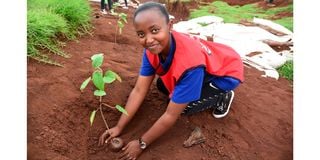Developing story: Iranian President Ebrahim Raisi confirmed dead in chopper crash
Why are we really planting trees?

Elizabeth Mukami from Kenya Red Cross plants a tree at Ngong Hill Forest Recreational Park, Corner Baridi in Kajiado county on May 24, 2022. The government and partners launched a community-led tree-planting initiative, the bedrock of the #JazaMiti, #15BillionTrees campaign.
What you need to know:
- Tree growing is more than just planting trees; it's about strategic ecosystem restoration that enhances the country's resilience against climate-induced flooding.
As we grapple with the aftermath of the recent devastating floods that swept through parts of Kenya, we join the nation in mourning the loss of life to yet another facet of the ongoing climate emergency.
These floods, exacerbated by the shifting climate, as outlined in the IPCC’s “Sixth Assessment Report”, serve as a stark reminder: Climate emergencies are becoming severer and more frequent.
Our response to them must evolve beyond mere reaction to proactive measures, prioritising ecosystem restoration, resilience and sustainability.
This approach not only mitigates the immediate impacts of flooding but also fosters long-term environmental stability. By prioritising the restoration of degraded ecosystems, particularly through tree planting, Kenya aligns with global best practices proven effective in mitigating flood impacts.
Unfortunately, cycles of floods are, in most cases, followed by cycles of droughts. Therefore, we must confront the future through deliberate efforts, including nature-based solutions.
Conservation, rehabilitation and climate-informed management of biodiversity and ecosystems increase resilience to climate change, offering cost-effective long-term solutions to safeguard lives, livelihoods and infrastructure and advance progress towards the Sustainable Development Goals (SDGs).
Trees play a critical role in flood mitigation through several mechanisms. Their root systems increase soil permeability, enhancing the ground’s capacity to absorb rainfall and reduce surface runoff. The canopy of trees also intercepts rain, slowing its descent to the ground, hence reducing erosion, which is a key contributor to flooding.
Moreover, forests act as water regulators, releasing water slowly into rivers and streams, thus moderating the flow during rainy seasons. Kenya joins the swelling ranks of countries that have successfully gone down this path as a means of mitigating the debilitating impact of floods.
To harness the full potential of tree growing for flood mitigation, Kenya, in collaboration with the private sector and international partners, under the patronage of President William Ruto, have today launched a new phase of the national tree-planting campaign.

Elephants in the Imenti Forest in Meru. Forests act as water regulators, releasing water slowly into rivers and streams, thus moderating the flow during rainy seasons.
This will help to amplify tree growing efforts, with a special emphasis on tree planting in flood-prone areas in support of community-led tree-planting initiatives, the bedrock of the #JazaMiti, #15BillionTrees campaign.
Collaboration with both the private sector and international partners around the support to the implementation, scaling up and sustainability of large-scale reforestation efforts remain key.
Measures currently underway are exploring how best to harmonise Kenya's policy, legislative and regulatory environment with international best practices as a means of helping crowd in both domestic and foreign, private and public investment in support of the green transition, including accelerating the adoption of sustainable practices contributing to ecosystem restoration.
Community engagement and education are central pillars to this programme. Engaging with local communities to ensure they fully harness the benefits of tree planting and are empowered to maintain and protect forests remains central to ensuring that Kenya reaps the dividends of ecosystem restoration.
Tree growing is more than just planting trees; it's about strategic ecosystem restoration that enhances the country's resilience against climate-induced flooding.
By adopting and adapting international best practices, Kenya can protect its landscapes and communities from the deleterious effects of floods while also contributing positively to global environmental efforts.
As the country confronts the multifaceted challenges stemming from the climate emergency, prioritising tree planting as a cornerstone of flood management charts a course towards a more sustainable and resilient future.
In the days and weeks ahead, the government, people and friends of Kenya stand in solidarity with those directly and indirectly impacted by these floods, mourning those lost and supporting their families and communities.
Yet we are buoyed by the understanding that our actions today sow the seeds for a brighter, greener, safer and more resilient tomorrow.
Ms Tuya is the Cabinet Secretary for Environment, Climate Change and Forestry of the Republic of Kenya. Ms Kariuki is the CEO, Kenya Private Sector Alliance (Kepsa). Mr Ngororano is the United Nations Development Programme (UNDP) Resident Representative in Kenya.






